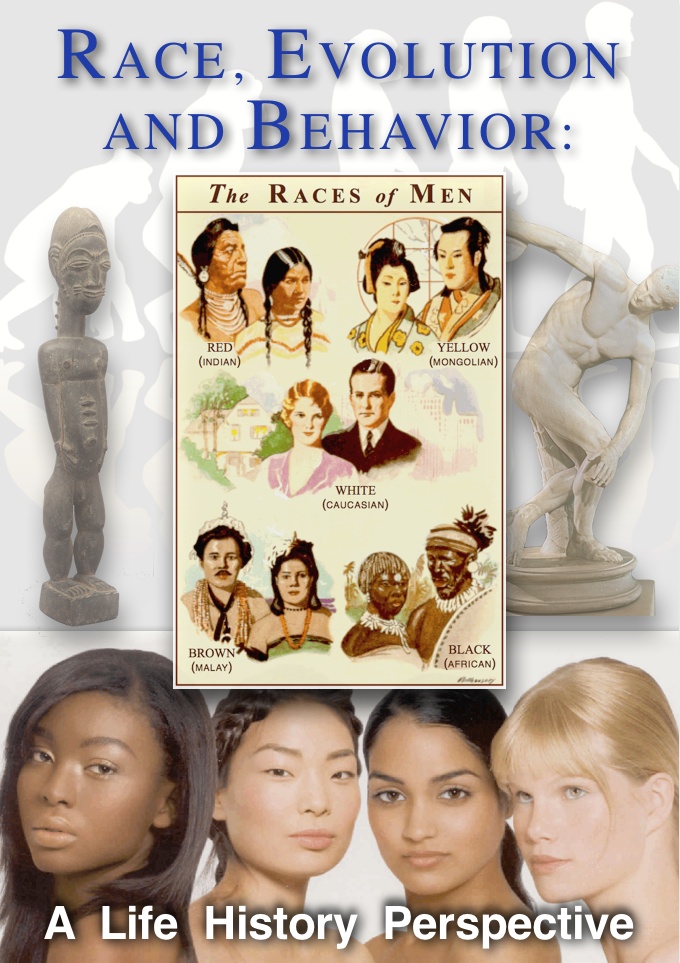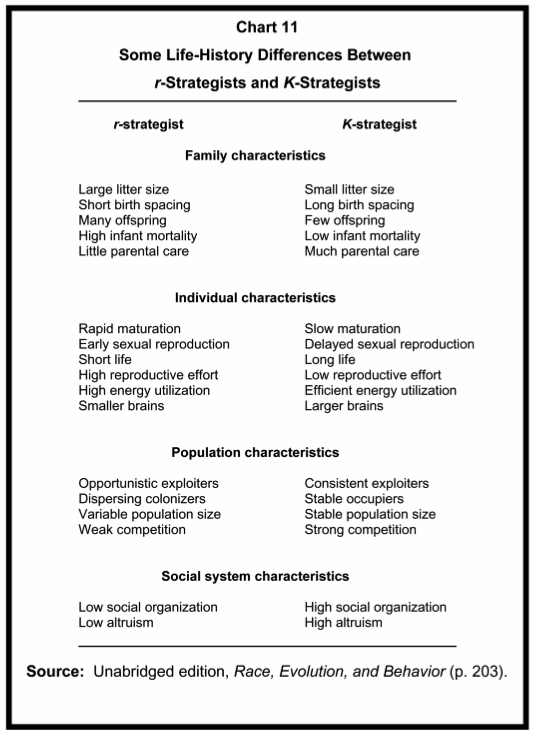RACE, EVOLUTION, AND BEHAVIOR:
A Life History Perspective
[Part 6]
2nd Special Abridged Edition
By Professor J. Philippe Rushton
University of Western Ontario
London, Ontario, Canada N6A 5C2
Author
J. Philippe Rushton is a professor of psychology at the University of Western Ontario, London, Ontario, Canada. Rushton holds two doctorates from the University of London (Ph.D. and D.Sc) and is a Fellow of the John Simon Guggenheim Foundation, the American Association for the Advancement of Science, and the American, British, and Canadian Psychological Associations. He is also a member of the Behavior Genetics Association, the Human Behavior and Evolution Society, and the Society for Neuroscience. Rushton has published six books and nearly 200 articles. In 1992 the Institute for Scientific Information ranked him the 22nd most published psychologist and the 11th most cited. Professor Rushton is listed in Who’s Who in Science and Technology, Who’s Who in International Authors, and Who’s Who in Canada.
[Page 5]
Contents
Preface 6
1. Race is More Than Skin Deep 7
Race in History
Race in Today’s World
Why Are There Race Differences?
Conclusion
Additional Readings
2. Maturation, Crime, and Parenting 13
Maturation
Crime
Personality, Aggression, and Self-Esteem
Parenting and Out-of-Wedlock Births
Longevity and Population Growth
Conclusion
Additional Readings
3. Sex, Hormones, and AIDS 18
Sexual Behavior and Attitudes
Sexual Physiology and Anatomy
AIDS and HIV
Conclusion
Additional Readings
4. Intelligence and Brain Size 22
Culture Fair Tests
Intelligence and Brain Size
Race Differences in Brain Size
Magnetic Resonance Imaging
Brain Weight at Autopsy
Measuring Skull Size
Measuring Living Heads
Summarizing Brain Size Differences
Conclusion
Additional Readings
5. Genes, Environment, or Both? 28
Heritability Studies
Adoption Studies
Race and Heritability
Trans-racial Adoption Studies
Heritabilities Predict Racial Differences
Regression to the Average
Conclusion
Additional Readings
6. Life History Theory 34
r-K Life History Theory
Race Differences and r-K Strategies
Testosterone — The Master Switch?
Conclusion
Additional Readings
7. Out of Africa 39
The Evidence
Geography and Race
Conclusion
Additional Readings
8. Questions and Answers 42
Is Race a Useful Concept? (Chapter 1)
Are the Race Differences Real? (Chapters 2 through 5)
Is the Relationship Between Race and Crime Valid? (Chapter 2)
Is the Relationship Between Race and Reproduction Valid? (Chapter 3)
Is the Genetic Evidence Flawed? (Chapter 5)
Is r-K Theory Correct? (Chapter 6)
Aren’t Environmental Explanations Sufficient? (Chapter 5)
Is Race Science Immoral? (Chapter 1)
Closing Thoughts
Additional Readings
[Page 6]
[Page 34]
6: Life History Theory
The theory of r-K life histories explains the worldwide three-way pattern in race differences. The r-strategy means being very sexually active and having many offspring. The K-strategy means having fewer offspring, but with both mother and father giving them more care. Humans are the most K strategists of all species. Among humans, Orientals follow the most K-strategy, Blacks the most r-strategy, and Whites fall in between.
The previous chapters showed that there are important race differences in brain size, hormone levels, even bone and tooth development, as well as sexual behavior, aggression, and crime. The three-way pattern in which the races differ — Orientals at one end, Blacks at the other, and Whites in between — is true all around the world. A look at history shows that the race differences we see today were also seen in the past.
Why do the races differ? Of course, poverty, nutrition, and cultural factors are important. But so too are the genes. Culture theory alone cannot explain all the findings.
r-K Life History Theory
Harvard University biologist E.O. Wilson was the first to use the term r-K Life-History Theory. He used it to explain population change in plants and animals. I have applied it to the human races.
A life-history is a genetically-organized group of traits that have evolved together to meet the trials of life — survival, growth, and reproduction. For our purposes, r is a term in Wilson’s equation that stands for the natural rate of reproduction (the number of offspring). The symbol K stands for the amount of care parents give to insure that their offspring survive. Plants and animals have different life history strategies. Some are more r and others are relatively more K.
The r and K strategists differ in the number of eggs they produce. The r-strategists are like machine-gunners. They fire so many shots that at least one of them will hit the target. The r-strategists produce many eggs and sperm, and mate and give birth often. The K-strategists, on the other hand, are like snipers. They put time and effort into a few carefully placed shots. K-strategists give their offspring a lot of care. They work together in getting food and shelter, help their kin, and have complex social systems. That is why the K-strategists need a more complex nervous system and bigger brain, but produce fewer eggs and sperm.
This basic law of evolution links reproductive strategy to intelligence and brain development. The less complex an animal’s brain, the greater its reproductive output. The bigger an animal’s brain, the longer it takes to reach sexual maturity and the fewer offspring it produces (see Chart 10). Oysters, for example, have a nervous system so simple that they lack a true brain. To offset this they produce 500 million eggs a year. In contrast, chimpanzees have large brains but give birth to one baby about every four years.
In different species of plants and animals we find a consistent pattern between these two variables — intelligence and reproductive rate. The number of offspring, the time between births, the amount of care parents give, infant mortality, speed of maturity, life span, even social organization, altruism, and brain size all fit together like pieces of a puzzle. The complete puzzle forms a picture biologists call the r-K Life History Strategy.
[Page 35]
The r-type life history involves higher levels of reproduction, while the K-type strategy requires greater parental care and use of mental attributes. Since larger brains need more time to be built, all the stages of development are also slowed down. The gestation period for some smaller-brained primates (like lemurs and monkeys) is 18 weeks. But for bigger-brained primates (like chimpanzees and gorillas) it is 33 weeks. Some monkeys have their first pregnancy at the age of nine months. Gorillas, which have bigger brains and greater intelligence, have their first pregnancy at ten years.
Monkeys are born with a brain very nearly 100% its adult size, while chimpanzees and gorillas are born with about 60% of adult brain size. Human babies are born with a brain that is less than 30% of its adult size. For the first few months of life, monkeys are better than apes in most tests of sensory-motor behavior. And infant apes are superior to infant humans on these tasks. The r-K relationship is true for different species and also applies to humans.
Chart 10 shows where various animals fall on the r-K scale. Different species are, of course, only relatively r or K. Rabbits are K-strategists compared to fish. But they are r-strategists compared to primates (monkeys, apes, and humans, who are the best K-strategists among mammals). Humans may be the most K species of all. And some humans are better K-strategists than others.
Chart 11 lists traits typical of r and K reproductive strategies. Every species and every race has a certain life history that we can describe in terms of r-K. The position of each species (or race) on the r-K scale shows the strategy that gave its ancestors the best chance to survive in their habitat.
Chart 12 shows the life phases and gestation times (conception to birth) for six different primates. They show a scale of increasing K, from lemur to macaque, to gibbon, to chimp, to early humans, to modern humans. Each step in the scale means that the species puts more time and energy into caring for its young and insuring their survival. Each step also means not having as many offspring. Note the different sizes of each of the phases for the different species in Chart 12. Only humans have the post reproductive (i.e., after menopause) phase.
[Page 36]
The differences in r-K strategies that exist even in primates are important. A female lemur is an r- strategist for a primate. She produces her first offspring at nine months and has a life expectancy of only 15 years. A female gorilla is a K-strategist. She has her first pregnancy at about age 10 years and can expect to live to the age of 40. The lemur may mature, have a number of young, and die before the gorilla has her first baby.
[Page 37]
Race Differences and r-K Strategies
How do the three races fall along the r-K scale? Look back at the pattern of racial differences in Chart 1 (page 19). Compare them to the r-K traits in Chart 11 (page 77). Orientals are the most K, Blacks are the most r, and Whites fall in between.
Being more r means:
* shorter gestation periods
* earlier physical maturation (muscular control, bone and dental development)
* smaller brains
* earlier puberty (age at first menstruation, first intercourse, first pregnancy)
* more developed primary sexual characteristics (size of penis, vagina, testes, ovaries)
* more developed secondary sexual characteristics (voice, muscularity, buttocks, breasts)
* more biological than social control of behavior (length of menstrual cycle, periodicity of sexual response, predictability of life history from start of puberty)
* higher levels of sex hormones (testosterone, gonadotropins, follicle stimulating hormone)
* higher levels of individuality (lower law abidingness)
* more permissive sexual attitudes
* higher intercourse frequencies (premarital, marital, extramarital)
* weaker pair bonds
* more siblings
* higher rates of child neglect and abandonment
* greater frequency of disease
* shorter life expectancy
[Page 38]
Testosterone — The Master Switch?
Testosterone may be a master switch that sets the position of the races on the r-K scale. We know that this male sex hormone affects self-concept, temperament, sexuality, aggression and altruism. It controls the development of muscles and the deepening of the voice. It can also contribute to aggression and problem behavior. A study of over 4,000 military veterans found high testosterone levels predicted greater criminality, alcohol and drug abuse, military misconduct, and having many sex partners.
We can now see how different testosterone levels among the three races might explain the r-K behavioral differences. With higher testosterone levels, Blacks are more likely to put time and energy into having offspring. On the other hand, Asians and Whites with lower testosterone levels put more time and energy into caring for a few offspring and making long term plans. But, how did this happen? And why? For the answers we must turn to human origins and the Out-of-Africa theory of racial evolution.
Conclusion
r-K Life History Theory, a basic principle of modern evolutionary biology, explains the three- way pattern of differences in brain size, IQ, and behavior, described earlier. Every species of plant or animal can be placed on the r-K scale. The r end of the scale means having more offspring, maturing earlier, having smaller brains and providing less parental care. The K end of the scale means having fewer offspring, maturing later, having larger brains, and providing more parental care. Humans are the most K species of all. Among humans, Orientals are the most K, Blacks the most r, and Whites fall in between.
Additional Readings
Johanson, D. C. & Edey, M. A. (1981). Lucy: The Beginnings of Humankind. New York: Simon & Schuster.
Lovejoy, C.O. (1981). The origin of man. Science, 211, 341-350.
Click here for Race, Evolution and Behavior >>>
Part 1: Preface; Race is More Than Skin Deep
Part 2: Maturation, Crime, and Parenting
Part 3: Sex, Hormones, and AIDS
Part 4: Intelligence and Brain Size
Part 5: Genes, Environment, or Both?
PDF of this blog post.
Click to view or download (2.0 MB). >> Race, Evolution, and Behavior – Part 6 Ver 2
Version History
Version 3: Jan 14, 2020 — Re-uploaded images and PDF for katana17.com/wp/ version.
Version 2: Aug 13, 2015 — Added Cover page; improved formatting; expanded Contents page; added updated PDF (ver 2).
Version 1: Published Jun 20, 2014






Pingback: Genitals animals: aus i peixos | All you need is Biology
Pingback: Genitales animales: aves y peces | All you need is Biology
Pingback: RACE, EVOLUTION, AND BEHAVIOR - Part 3: Sex, Hormones, and AIDS - katana17katana17
Pingback: RACE, EVOLUTION, AND BEHAVIOR - Part 5: Genes, Environment, or Both? - katana17katana17
Pingback: RACE, EVOLUTION, AND BEHAVIOR - Part 7: Out of Africa - katana17katana17
Pingback: RACE, EVOLUTION, AND BEHAVIOR - Part 8: Questions and Answers - katana17katana17